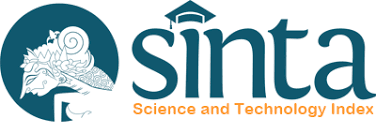Role of parents relates to vegetable and fruit comsumption on students at Junior High School Hang Tuah 2 Jakarta
DOI:
https://doi.org/10.22236/argipa.v5i1.3894Abstract
Consumption of vegetables and fruit in junior high school students in South Jakarta is very low. Various factors affect the consumption of vegetables and fruits including knowledge of nutrition, the role of parents, peers, and exposure to mass media. This study's purpose was to determine the relationship of nutritional knowledge, the role of parents, peers, and exposure to mass media with the consumption of vegetables and fruit in Hang Tuah 2 Middle School students. The subjects in this study were students in classes VII and VIII, totaling 130 samples, taken by simple random sampling technique. This study used a cross-sectional design conducted in February-August 2019. Data of knowledge, role of parents, peers, and mass media exposure were taken by interview using a structured questionnaire. Data on vegetable and fruit consumption was taken with Semi-Quantitative Food Frequency. Data analysis using Chi-Square Test. This study showed that 88.5% of students consume less fruits and vegetables. There was a significant relationship between the role of parents with fruit and vegetable consumption (p=0,007), while nutritional knowledge, the role of peers, and exposure to mass media did not have a significant relationship with fruit and vegetable consumption.
Keywords: Fruits and Vegetables, Media Exposure, Nutrition Knowledge, Role of Friends, Role of Parents
Downloads
References
Afif, PA. & Sumarmi, S. (2017). Peran ibu sebagai edukator dan konsumsi sayur buah pada anak. Amerta Nutr, 1(3): 236-242.
Almatsier, S., Soetardjo, S. & Soekatri, M., (2011). Gizi Seimbang dalam Daur Kehidupan. Jakarta: Gramedia Pustaka Utama.
Alonso, A., de la Fuente, C., Martín-Arnau, AM., de Irala, J., Martínez, JA., Martínez-González, MA. (2004). Fruit and vegetable consumption is inversely associated with blood pressure in a Mediterranean population with a high vegetable-fat intake: The Seguimiento Universidad de Navarra (SUN) Study. Br J Nutr. 92(2): 311–9.
Annur, DR., (2014). Hubungan Faktor Individu dan Lingkungan dengan Konsumsi Buah dan Sayur pada Siswa SMPN 19 Jakarta Tahun 2014. Skripsi. Depok: Departemen Ilmu Gizi, Fakultas Kesehatan Masyarakat, Universitas Indonesia.
Attorp, A., Scott, JE., Yew, AC., Rhodes, RE., Barr, SI., Naylor, P-JJ. (2014). Associations between socio-economic, parental and home environment factors and fruit and vegetable consumption of children in grades five and six in British Columbia, Canada. BMC Public Health, 14(1): 150.
Bahria & Triyanti. (2010). Faktor-faktor yang terkait dengan konsumsi buah dan sayur pada remaja di 4 SMA Jakarta Barat. Jurnal Kesehatan Masyarakat Andalas, 4(2): 63-71.
Bourdeaudhuij, ID. Velde, ST., Brug, J., Due, P., Wind, M., Sandvik, C., Maes, L., Wolf, A., Rodrigo, CP., Yngve, A., Thorsdottir, I., Rasmussen, M., Elmadfa, I., Franchini, B., & Klepp, KI. (2008). Personal, social and environmental predictors of daily fruit and vegetable intake in 11 year-old children in nine European countries. Eur J Clin Nutr. 62(7): 834-841.
Brug J., Tak, NI., te Velde, SJ., Bere, E., Bourdeaudhuij, ID. (2008). Taste preferences, liking and other factors related to fruit and vegetable intakes among school children: results from observational studies. Br J Nutr. 99 Suppl 1(2008): S7–14.
Cornelia, J., (2015). Faktor-faktor yang Berhubungan dengan Konsumsi Buah dan Sayur pada Mahasiswa Ikatan Mahasiswa Riau Universitas Indonesia Depok Tahun 2015. Skripsi. Depok: Departemen Ilmu Gizi, Fakultas Kesehatan Masyarakat, Universitas Indonesia
Evans, D. (2008). Social Media Marketing an Hour a Day. Indianapolis: Wiley Publishing Inc.
Hammons, AJ. & Fiese, BH. (2011). Is frequency of shared family meals related to the nutritional health of children and adolescents? Pediatrics, 127(6): e1565–74.
Harris, TS. & Ramsey, M. (2014). Paternal modeling, household avalibilty and paternal intake as predictors of fruit, vegetable and sweet beverage consumption among African American Children. Appetite, 85: 171-177.
He, FJ., Nowson, CA., Lucas, M., & MacGregor, GA. (2007). Increased consumption of fruit and vegetables is related to a reduced risk of coronary heart disease: meta-analysis of cohort studies. J Hum Hypertens, 21: 717–28.
Hidayati, D., Suyatno, Aruben, R., & Pradigdo, SF. (2017). Faktor risiko kurang konsumsi buah dan sayur pada anak usia sekolah dasar (Studi kasus-kontrol pada siswa SDN Sendangmulyo 03 Semarang tahun 2017). Jurnal Kesehatan Masyarakat, 5(4): 638-647.
Hota, M., & McGuiggan, R. (2005). The relative influence of consumer socialization agents on children and adolescents – examining the past and modeling the future. [internet] diakses pada tanggal 29 Mei 2020. http://www.acrwebsite.org/volumes/1383 1/eacr/vol7/E-07
Boynton-Jarrett, R., Thomas, TN., Peterson, KE., Wiecha, J., Sobol, AM., & Gortmaker, SL. (2007). Impact of television viewing pattern on fruits and vegetable consumption among adolescents. Pediatric Journal American, 112: 1321-1326.
Kemenkes. (2014). Studi Diet Total Survei Konsumsi Makanan Individu Provinsi DKI Jakarta. Jakarta: Badan Penelitian dan pengembangan Kesehatan.
Kementerian Pertanian. (2018). Survei Sosial Ekonomi Nasional. Jakarta: Badan Ketahanan Pangan.
Kristjansdottir, AG., Thorsdottir, I., Bourdeaudhuij, ID., Due, P., Wind, M., & Klepp, KI. (2006). Determinants of fruit and vegetable intake among 11-year-old school children in a country of traditionally low fruit and vegetable consumption. Int J Behav Nutr Phys Act, 3(41).
Krolner, R., Rasmussen, M., Brug, J., Klepp, KI., Wind, M., & Due, P. (2011) Determinants fruit and Vegetable consumption among children and adolescents: a review of the literature. Part II: qualitative studies. Int J Behav Nutr Phys Act., 8(112): 1-38.
Kusumaningrum, MD., (2014). Perbedaan Proporsi Ketersediaan Buah dan Sayur di Rumah dan Faktor Lainnya terhadap Konsumsi Buah dan Sayur Siswa SDN Jatirahayu VIII Bekasi Tahun 2014. Skripsi: Depok: Departemen Ilmu Gizi, Fakultas Kesehatan Masyarakat, Universitas Indonesia.
Lestari, ID. (2013). Identifikasi perilaku diet remaja putri menggunakan teori pendekatan WHO. Jurnal Promkes, 1: 67-75.
Lock, K., Pomerleau, J., Causer, L., Altmann, DR., McKee, M. (2005). The global burden of disease attributable to low consumption of fruit and vegetables: implications for the global strategy on diet. World Health Organization. 83(2): 100–8
Melinda, K., (2013). Faktor-faktor yang Berhubungan dengan Konsumsi Buah dan Sayur pada Remaja di SMP Negeri 28 Jakarta dan SMP Negeri 1 Jakarta Tahun 2013. Skripsi. Depok: Departemen Ilmu Gizi, Fakultas Kesehatan Masyarakat, Universitas Indo-nesia.
Mohammad, A. & Madanijah, S. (2015). Konsumsi buah dan sayur anak usia sekolah dasar di Bogor. Jurnal Gizi dan Pangan, 10(1): 71-76.
Noviyanti, RD. & Marfuah, D. (2017). Hubungan pengetahuan Gizi, Aktivitas fisik,dan pola makan terhadap status gizi remaja di kelurahan purwosari Laweyan Surakarta. Proceeding The 6th University Research Colloquium 2017. Magelang: Universitas Muhammadiyah Magelang.
Nooyens, ACJ. Bueno-de-Mesquita, HB., van Boxtel, MPJ., van Gelder, BM., Verhagen, H., & Verschuren, WMM. (2015). Fruit and vegetable intake and cognitive decline in middle-aged men and women: the doetinchem cohort study. Br J Nutr, 106(5): 752-61.
Pearson N, Timperio A, Salmon J, Crawford D, Biddle SJH. ( 2009). Family Influences on Children's Physical Activity and Fruit and Vegetable Consumption. Int J Behav Nutr Phys Act 7: 1–7.
Riboli, E. & Norat, T. (2003). Epidemiologic evidence of the protective effect of fruit and vegetables on cancer risk. Am J Clin Nutr, 78(3 Suppl): 559S-569S.
Sediaoetama, AD. (2005). Ilmu Gizi untuk Mahasiswa dan Profesi di Indonesia Jilid II. Jakarta: Dian Rakyat.
Sharps, M., Higgs, S., Blissett, J., Nouwen, A., Chechlacz, M., Allen, HA., Robinson, E. (2014). Examining evidence for behavioural mimicry of parental eating by adolescent females : an observational study. Journal of Appetite, 89: 56-61.
Truswell, AS. (2003). ABC of Nutrition. 4th ed. London: BMJ Publishing Group.
WHO. (2011). Joint FAO/WHO Workshop on Promotion of the Production and Consumption of Fruits and Vegetables. Arusha.
Wu, Y., Zhang, D., Jiang, X., & Jiang, W. (2015) Fruit and vegetable consumption and risk of type 2 diabetes mellitus: a dose-response meta analysis of prospective cohort studies. Nutr Metab Cardiovasc Dis., 25(2): 140–7.
Wyse, R., Campbell, E., Nathan, N., Wolfenden, L. (2011). Associations between characteristics of the home food environment and fruit and vegetable intake in preschool children: a cross-sectional study. BMC Public Health, 11: 10.

















